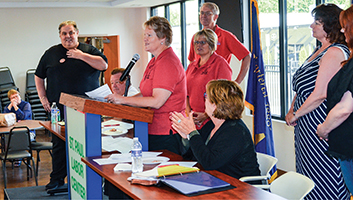
A Tale of Two Votes

|
Barb Swenson (center), a German language teacher in North Branch, Minn., thanked delegates to the St. Paul Regional Labor Federation for supporting the school district’s successful referendum campaign in May.
PHOTO © BY MICHAEL MOORE, ST. PAUL UNION ADVOCATE, ST. PAUL, MINN. |
On May 24, 2016, voters in the North Branch Public Schools, located 30 minutes north of St. Paul, Minn., came to the polls to cast ballots for or against a proposal to issue $62.1 million in new debt to fund various school district building proposals.
The proposal included projects to improve operating efficiency, safety and security, better traffic patterns, upgrades and remodeling to support instruction, and improvements to facilities used for student activities and community events.
Although the district had a challenging history, having lost 10 of the last 12 referenda ballot questions since 1998, there was reason to be hopeful. The referendum was being held just as old debt was scheduled to retire, meaning that the district could offer a zero tax-increase building project.
Lengthy Analysis
As the judges completed the ballot count, hopeful expectation was replaced with disappointment — the referendum had come up short of the required 50 percent plus one needed for approval by just 125 votes.
In the months that followed, North Branch’s superintendent, Deb Henton, and the school board took stock of the situation and began a year-long effort to analyze what had happened and to begin “brick by brick” the hard work of building a foundation capable of supporting a positive outcome in the future. The building needs were not going away, and the district needed to find a way to support students, staff and the community.
The good news was that the May referendum had failed by only 125 votes and the school board, administration and citizens involved in the campaign were motivated to try again soon.
An Energized Turnout
Consider the “15 to 20 to 25” realities in North Branch’s failed 2016 referendum:
» Parents of school-age children attending the district accounted for only 23.4 percent of all registered voters.
» Turnout among young parents (18-40 years old) came in at a meager 19.8 percent with total parent turnout at only 27 percent.
» In polling after the 2016 defeat, but before the second try in May 2017, 21 percent agreed with the statement, “I would not vote for any tax increase of any amount for any purpose.”
As one can see, all three scarcity characteristics in North Branch were in line with the challenges summarized in the accompanying article.
In May 2017, the district was armed with better data from both a feasibility survey of voters who participated in the 2016 referendum, demographic results of a post-election analysis and use of both demographic and predictive databases to develop a voter target structure for the campaign.
The school board ultimately broke up the proposal into three ballot questions totaling $70 million ($8 million more than in 2016). The district also used GuideK12, a geovisual planning tool, to map its voter targets to support voter canvassing and GOTV. The district was rewarded for its strategic approach, winning all three ballot questions. While the demographics of the district did not change in a year, the turnout numbers were much better:
» Turnout among young parents (18-40 years old) was 35.6 percent, a 79 percent improvement over the 2016 ballot defeat.
» Turnout among all parents was 39.4 percent, a 46 percent improvement over the previous year’s defeat.
» The campaign achieved a turnout of 54.7 percent for its top two identified “yes” voter target groups, compared to a 24 percent turnout overall.
» The campaign targeted and turned out 759 early voters compared to only 122 in the failed election.
— DON LIFTO